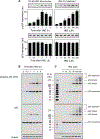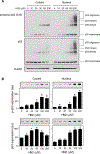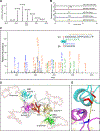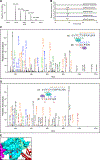Nitrogen Mustard Alkylates and Cross-Links p53 in Human Keratinocytes
- PMID: 35312310
- PMCID: PMC9491701
- DOI: 10.1021/acs.chemrestox.1c00420
Nitrogen Mustard Alkylates and Cross-Links p53 in Human Keratinocytes
Abstract
Cytotoxic blistering agents such as sulfur mustard and nitrogen mustard (HN2) were synthesized for chemical warfare. Toxicity is due to reactive chloroethyl side chains that modify and damage cellular macromolecules including DNA and proteins. In response to DNA damage, cells initiate a DNA damage response directed at the recruitment and activation of repair-related proteins. A central mediator of the DNA damage response is p53, a protein that plays a critical role in regulating DNA repair. We found that HN2 causes cytosolic and nuclear accumulation of p53 in HaCaT keratinocytes; HN2 also induced post-translational modifications on p53 including S15 phosphorylation and K382 acetylation, which enhance p53 stability, promote DNA repair, and mediate cellular metabolic responses to stress. HN2 also cross-linked p53, forming dimers and high-molecular-weight protein complexes in the cells. Cross-linked multimers were also modified by K48-linked ubiquitination indicating that they are targets for proteasome degradation. HN2-induced modifications transiently suppressed the transcriptional activity of p53. Using recombinant human p53, HN2 alkylation was found to be concentration- and redox status-dependent. Dithiothreitol-reduced protein was more efficiently cross-linked indicating that p53 cysteine residues play a key role in protein modification. LC-MS/MS analysis revealed that HN2 directly alkylated p53 at C124, C135, C141, C176, C182, C275, C277, H115, H178, K132, and K139, forming both monoadducts and cross-links. The formation of intermolecular complexes was a consequence of HN2 cross-linked cysteine residues between two molecules of p53. Together, these data demonstrate that p53 is a molecular target for mustard vesicants. Modification of p53 likely mediates cellular responses to HN2 including DNA repair and cell survival contributing to vesicant-induced cytotoxicity.
Conflict of interest statement
The authors declare no competing financial interest.
Figures








Similar articles
-
Cross-linking of thioredoxin reductase by the sulfur mustard analogue mechlorethamine (methylbis(2-chloroethyl)amine) in human lung epithelial cells and rat lung: selective inhibition of disulfide reduction but not redox cycling.Chem Res Toxicol. 2014 Jan 21;27(1):61-75. doi: 10.1021/tx400329a. Epub 2013 Dec 9. Chem Res Toxicol. 2014. PMID: 24274902 Free PMC article.
-
Thioredoxin Cross-Linking by Nitrogen Mustard in Lung Epithelial Cells: Formation of Multimeric Thioredoxin/Thioredoxin Reductase Complexes and Inhibition of Disulfide Reduction.Chem Res Toxicol. 2015 Nov 16;28(11):2091-103. doi: 10.1021/acs.chemrestox.5b00194. Epub 2015 Oct 19. Chem Res Toxicol. 2015. PMID: 26451472 Free PMC article.
-
Sulfur Mustard Analog Mechlorethamine (Bis(2-chloroethyl)methylamine) Modulates Cell Cycle Progression via the DNA Damage Response in Human Lung Epithelial A549 Cells.Chem Res Toxicol. 2019 Jun 17;32(6):1123-1133. doi: 10.1021/acs.chemrestox.8b00417. Epub 2019 Apr 22. Chem Res Toxicol. 2019. PMID: 30964658 Free PMC article.
-
DNA damage signaling in the cellular responses to mustard vesicants.Toxicol Lett. 2020 Jun 15;326:78-82. doi: 10.1016/j.toxlet.2020.03.008. Epub 2020 Mar 12. Toxicol Lett. 2020. PMID: 32173488 Free PMC article.
-
Sulfur and nitrogen mustards induce characteristic poly(ADP-ribosyl)ation responses in HaCaT keratinocytes with distinctive cellular consequences.Toxicol Lett. 2016 Feb 26;244:56-71. doi: 10.1016/j.toxlet.2015.09.010. Epub 2015 Sep 14. Toxicol Lett. 2016. PMID: 26383629
Cited by
-
Dysregulation of the mTOR pathway by mechlorethamine.Toxicology. 2023 Mar 1;486:153434. doi: 10.1016/j.tox.2023.153434. Epub 2023 Jan 26. Toxicology. 2023. PMID: 36708981 Free PMC article.
References
-
- Dacre JC; Goldman M Toxicology and pharmacology of the chemical warfare agent sulfur mustard. Pharmacol. Rev. 1996, 48 (2), 289–326. - PubMed
-
- Singh RK; Kumar S; Prasad DN; Bhardwaj TR Therapeutic journery of nitrogen mustard as alkylating anticancer agents: Historic to future perspectives. Eur. J. Med. Chem. 2018, 151, 401–433. - PubMed
Publication types
MeSH terms
Substances
Grants and funding
LinkOut - more resources
Full Text Sources
Molecular Biology Databases
Research Materials
Miscellaneous

